Heart imagery and a dancing brush.
The calligraphy work that dominated the exhibition was a monumental 15m long masterpiece entitled “Mt. Fuji. “Into the future Japan” (Figure 5), based on a classic by the Japanese poet Kusano Shinpei (草野心平, くさの しんぺい、1903 – 1988), entitled 富士山作品第参 (ふじさんさくひんだいさん, “M. Fuji. Third poem.”). This work was written with a bundle of three brushes, which helped in creating the unforgettable brush stroke patterns. It is incredibly dynamic, abundant in kasure (掠れ,かすれ, i.e. “streaks of white”), where the brush is loaded with insufficient ink, or simply was moved with greater speed. A few lines of the poem were written in bold katakana, which imbues this magnificent calligraphy with masculine energy.
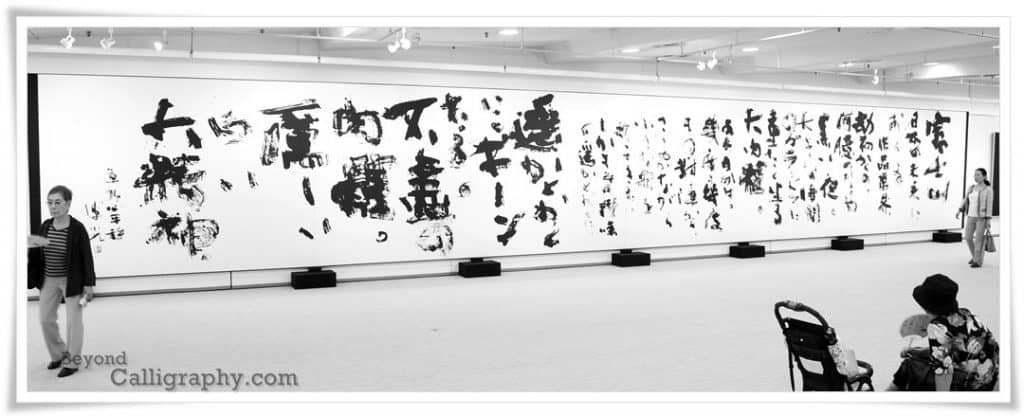
Another work that attracted my attention was the one shown in Figure 6. Before I even noticed the supple brushstrokes I was embraced by the soothing warmth of blurred ink and its tea-colour shading. This particular poem is taken from the poetry anthology entitled “Heaven” (天, てん, ten) which was also written by Kusano Shinpei. Just as the poem describes the magnificent scene of colourful interactions between the sea, clouds and heavens, this calligraphy does it with only two colours and ingenious brushstrokes, capturing the changing moods of the skies poured from the soul onto the sea of paper by this wizard of ink.
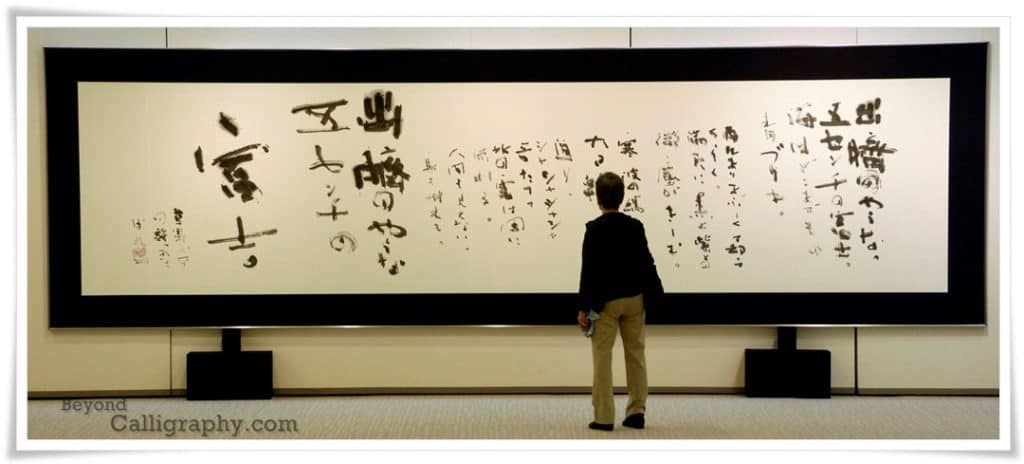
I will try to translate this poem for you, to help you visualise how picturesque and stunning it is. It is not a word for word translation, as no poetry should be translated that way, however I tried to stay as close to the original as possible.
Like a protruding navel
五センチの富士
Mount Fuji, five centimeters tall
海はどこまでもの青ブリキ
Embraced by a blue tin-plate-like sea horizon
Overwhelmed by the dazzling darkness
満天に黒と紫との微塵がきしむ
Of the cracking black and violet atoms of the whole sky
寒波の縞は大日輪めがけて迫り
And a cold wave approaching a sinking sun
シャシャシャシャ
Hum of the winds
音たてて氷の雲は風に流れる
And the restless sound of flowing icy clouds
No man that I can see
鳥も樹木も
No birds no arbor either
出臍のような
Only like protruding navel
五センチの富士
Mount Fuji, five centimetres tall
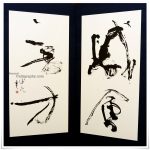
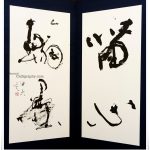
Calligraphy is a “heart imagery”, which offers us magical powers to paint with words of the soul. It is a poem within a poem, a painting within a painting, and an art within an art. I really love this picture (Figure 6), on which the Japanese lady is embraced by the dazzling skies of ink, her mind is overwhelmed by the world of the white sea of paper, and her soul is melting into the realm spawned by masterful brush strokes.
The next calligraphy works that I would like to say few words about are two byōbu (屏風, びょうぶ, i.e. “wind screen”) in modern cursive script (草書, そうしょ, sōsho). Both works were written with a very soft wool brush (羊毛筆, ようもうふで, yōmō fude), which delivers characteristic expressive lines. The text in Figure 7 reads 感會無方 (かんかいむほう, kankai muhō, i.e “awakening an infinite interest in something”). Obviously, it is a reference to the eternal passion for calligraphy and creativity through writing. It is a stunning work, full of movement and vigour.
The work shown in Figure 8 reads 留心翰墨 (りゅうしんかんぼく、ryūshinn kanboku, i.e. “a mind captivated by the brush and ink (calligraphy)). This work is written in a similar style to the one shown in figure 7. Particularly outstanding are the extremely fast and furious brush strokes of the bottom character in the left-hand side of the wind screen; the character 墨 (すみ, sumi, i.e “ink”). While looking at the entire work, the eye is captivated when we reach this climax point. For a moment our mind dissipates into the realm of nothingness, freezing our being and the surrounding world becomes a monochromatic fantasy.
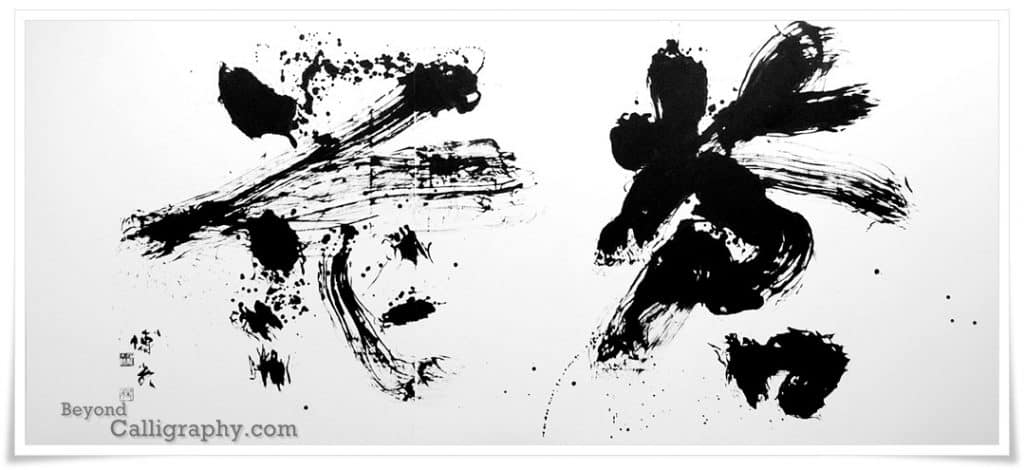
Figure 9 is a great example of how the knowledge of classical poetry can enhance the meaning of calligraphy, and how deep the world of ink and brush really is. Plainly translated the written phrase, 蒼茫 (そうぼう, sōbō), means “dusky” or “shadowy”. However, it is taken from the poetry verse by 王維 (Wáng Wéi, 699 – 759), a Chinese poet of the Tang dynasty (唐朝, 618 – 907), that reads: 蒼茫対落暉 (Chinese: cāng máng duì làhuī), which can be roughly translated to: “a vast (hazy) horizon contrasted with rays of the setting sun”. Consequently, 蒼茫 means “vast (mesmerising) skies”
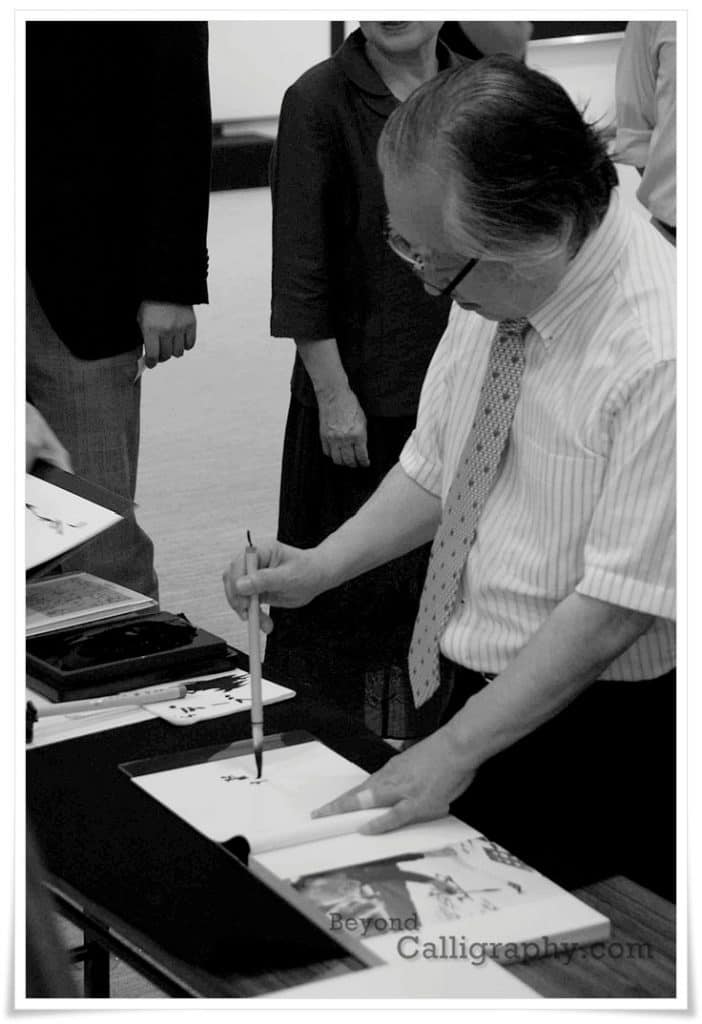
To be continued in Part 3.
